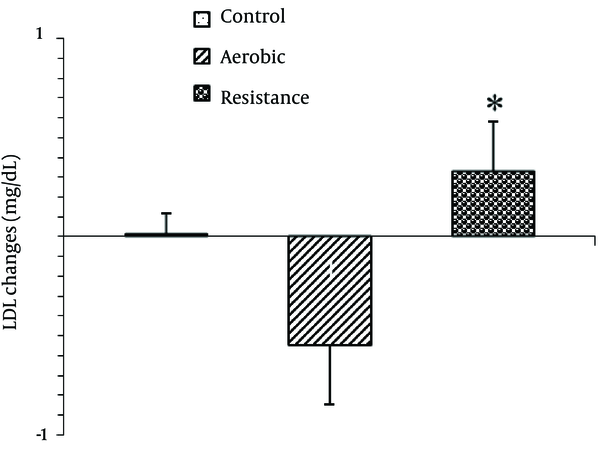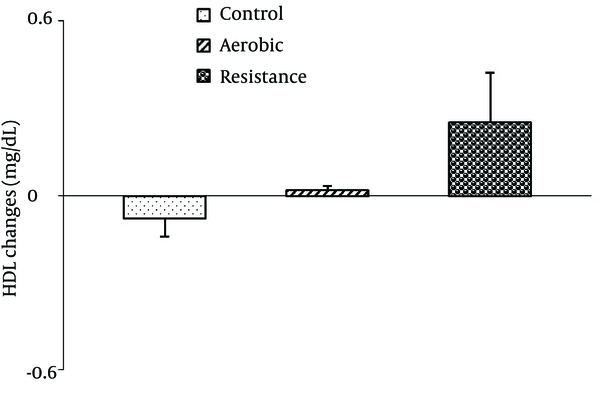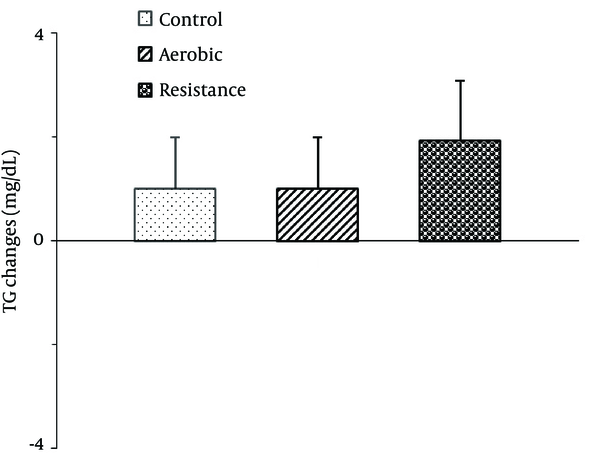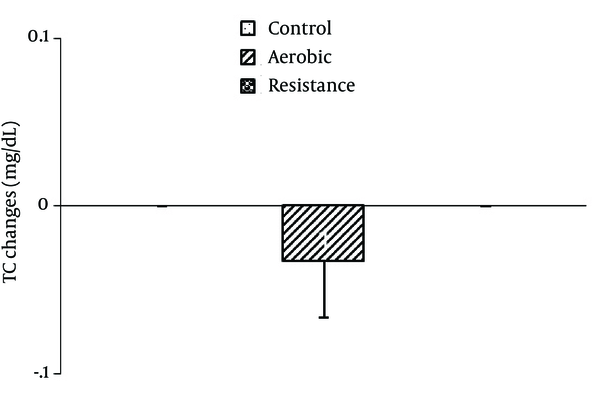Abstract
Background:
Exercise and physical activity is an effective way for maintaining health by modifying lipid profile. Many studies reported that even a single session of exercise could affect blood lipid profile. Nowadays, saliva sampling is an effective and noninvasive method in disease diagnosis and monitoring health. Based on the results, there is a significant and positive association between saliva and blood lipid values.Objectives:
Our aim was to assess acute effects of aerobic and resistance exercise on salivary lipid profile.Materials and Methods:
In this randomized clinical trial study, forty-five non-athlete women (18-35 years old, 18.5 ≤ BMI ≤ 25) were put in three groups (aerobic, resistance and control). Aerobic group program consisted of 30 minutes of aerobic exercise at 60-75% maximum heart rate (MHR) intensity and resistance group performed five resistance exercises at intensity of 75% 2-RM. Salivary Lipid profile was measured after 12 hours of fasting at 8 a.m. and immediately after exercise.Results:
One single session of aerobic and resistance did not induce significant change in salivary lipid profile. However, a significant difference was observed between changes in aerobic and resistance groups (P=0.03).Conclusions:
This study suggested that one session of aerobic and resistance exercise with moderate intensity did not change salivary lipid profile.Keywords
1. Background
Exercise and physical activity can be an effective way for maintaining health and fitness in different age groups and populations (students, soldiers, elderly, etc.) (1, 2). Benefits of exercise include increasing functional capacity (aerobic capacity, skeletal muscle strength and flexibility), cardiovascular function improvement, cardiovascular diseases risk factors reduction (via modifying lipid profile, glucose tolerance and blood pressure) and other benefits (2, 3).
Decrease in total cholesterol (TC), low-density lipoprotein cholesterol (LDL-C), triglyceride (TG) and elevations in high-density lipoprotein cholesterol (HDL-C) are favorable changes observed after exercise. Changes are associated with maintenance of health and prevention of disease (4-6). Resistance and aerobic exercises are both recommended as part of an overall strategy to modify lipid profiles (7, 8). Many studies reported that even a single session of exercise could affect blood lipid profile (9-11). However, in most previous studies, plasma lipid levels were examined before and after one session of prolonged exercise such as a marathon run (12-14). Results of studies examining acute effect of aerobic exercise on plasma lipid profile are contradictory (15). There is a little study regarding the effect of resistance exercise on lipid profile (16). Most of these investigations examined lipid profile response after exercise in male (17, 18) and there are little researches on women (19).
In the second half of the twenty century, the hypothesis of using saliva as a medium for monitoring general health, diagnosis and disease detection was made (20). This noninvasive method has several advantages over blood sampling such as easily repeatable, stress-free sampling, lower costs and painless collecting (21). Many studies demonstrated that the amounts of salivary lipids reflect values of serum lipids to some extent. The results of investigations showed a significant correlation between serum and salivary TC, TG, HDL-C, LDL-C and very low density lipoprotein cholesterol (VLDL-C); therefore, measurement of lipids by saliva sampling is a useful method to determine lipid profile level (22-27).
There is no study to assess the effectiveness of a single session of exercise on salivary lipid profile.
2. Objectives
The aim of this study was to determine the effects of a single session of aerobic and resistance exercise on salivary lipid profile in healthy non-athletic women.
3. Material and Methods
This study was performed for six months, between May 2014 and September 2014. In this randomized clinical trial study, forty-five non-athlete volunteer females (18.5 ≤ BMI ≤25 kg/m2, aged 18-35 years) were participated (Table 1). Before participation in the study, subjects signed an informed consent form and completed the general health questionnaire (GHQ-28) (28). inclusion criteria were no participation in a regular exercise program for the previous six months, regular menstrual period for the least six months (27-32 days), no medical conditions (e.g. cardiovascular, orthopedic, metabolic and respiratory diseases), no change of body weight for at least six months, no current consumption of alcohol and no consumption of medications. Subjects were excluded if they had symptoms such as dizziness, paleness and tachycardia. Besides, individuals with symptoms and signs of any active oral inflammation, periodontitis or severe gingivitis excluded from the study. Subjects randomly assigned into equal three groups of aerobic, resistance and control.
| Variables | Control Group | Aerobic Group | Resistance Group | F2,42 | P Value |
|---|---|---|---|---|---|
| Age, y | 25.20 ± 0.29 | 26.13 ± 0.55 | 25.67 ± 0.83 | 0.59 | 0.55 |
| BMI | 21.48 ± 0.60 | 21.50 ± 0.61 | 21.23 ± 0.45 | 0.07 | 0.93 |
| Waist to Hip ratio | 0.75 ± 0.01 | 0.72 ± 0.01 | 0.70 ± 0.00 | 2.57 | 0.08 |
| Saliva flow rate before intervention, mL/min | 0.21 ±0.01 | 0.22 ± 0.01 | 0.21 ± 0.06 | 0.18 | 0.83 |
| Saliva flow rate after intervention, mL/min | 0.26 ± 0.01 | 0.27 ± 0.01 | 0.24 ± 0.07 | 1.20 | 0.30 |
3.1. Anthropometric Measurement
At a preliminary session, subjects came to the laboratory to familiarize with the equipment and procedure. Then, indexes of anthropometric (weight, height, waist and hip circumference) were measured. Their height was measured by a wall chart and weight was measured by a digital scale. Body mass index was calculated by dividing the weight (kg) by square height (m2). Waist circumference was measured at the end of expiration in the thinnest part by tape meter. Also for measuring the hip size, the level of maximal protrusion of the gluteal muscles was selected (29).
3.2. 2-RM Test
2-RM test was determined for subjects in resistance group. The 2-RM is approximately equal with 90% of maximal voluntary contraction. This method reduces the risk of musculoskeletal injury and was used in many studies (30).
3.3. First Saliva Sampling
A week after the preliminary session, the subjects came to laboratory after 12 hours of fasting (22). Subjects were informed about the saliva sampling procedure. For all subjects, unstimulated saliva samples were obtained in 8 a.m. while the subjects were in a comfortable position (22). Saliva collection was performed by spitting directly into the plastic tube for a few minutes until sufficient volume (approximately 3 mL) was collected. Then, subject had a breakfast of about 550 KCal consisting of medium sized cake and low fat milk (31). At 9 a.m., subjects in each group performed a single session of exercise based on their respective group.
3.4. Aerobic Group
At the beginning of exercise session, subjects had a five-minute warm-up (32). The warm-up protocol was consisted of four stretching movements with 1set of two repetitions, while holding each position for 15 seconds and pedaling at zero resistance, which followed by 15 minutes running on treadmill and 15 minutes pedaling a stationary bicycle. The exercise intensity was 60-75% of the maximum heart rate (MHR), using “220-age” equation. A 2.5-minute warm-up phase followed by 10 minutes training phase with 60-75% MHR and a 2.5-minute cool down phase was used for the aerobic group.
3.5. Resistance Group
A similar five-minute warm-up was performed. Subjects performed five different resistance exercises in a same order; knee extension, knee flexion, elbow extension, elbow flexion and arm crossing across chest. Two sets of 10 repetitions at intensity of 75% of 2-RM were performed. A 30-second rest was allowed between sets of exercises. The session lasted about 30 minutes.
3.6. Control Group
Saliva sampling was performed at 8 a.m. and then had a breakfast similar to the other two groups. The control group had no exercise program and did not get extra calories until the second sampling.
3.7. Second Saliva Sampling
Immediately at the end of exercise session of the both groups, unstimulated saliva samples were collected. Second sampling of the control group was performed at 9:30 a.m. Saliva samples were centrifuged for 10 minutes at 4000 rpm (22). Samples were stored at -80 ˚C. Salivary lipid levels were measured by enzymatic photometric method. Salivary LDL-C was measured using the Friedewald formula (33) (Table 2). Changes of lipid profiles were calculated as second samples (after intervention) minus first samples (before intervention).
| Variables | Control Group | Aerobic Group | Resistance Group | F2,42 | P Value |
|---|---|---|---|---|---|
| LDL, mg/dL | 0.45 ± 0.09 | 0.93 ± 0.32 | 0.30 ± 0.09 | 2.56 | 0.09 |
| HDL, mg/dL | 0.82 ±0.03 | 0.74 ± 0.04 | 0.73 ± 0.05 | 0.78 | 0.46 |
| TG, mg/dL | 3.23 ± 0.67 | 3.91 ± 0.43 | 3.31± 0.40 | 0.49 | 0.61 |
| TC, mg/dL | 1.70 ± 0.11 | 1.64 ± 0.13 | 1.62 ± 0.14 | 0.22 | 0.80 |
3.8. Statistical Analysis
All statistical analyses were performed using SPSS version 17 (IBM, Chicago, USA). Kolmogorov-Smirnov test was used to determine the homogeneity of data distribution. Between group differences were determined using one-way ANOVA followed by Tukey post hoc test. The level of significance was considered at P < 0.05.
4. Results
The baseline physical characteristics including BMI and waist-to-hip ratio were not statistically different between the groups (Table 1). Baseline values of salivary lipids are presented in Table 2. There were no significant differences between the groups for baseline levels of salivary LDL-C, HDL-C, TG and TC. One way ANOVA showed a significant difference regarding mean LDL-C changes between the groups [F2,42=3.54, P=0.03; Figure 1 ]
Post Hoc analyses showed that the mean salivary LDL-C significantly decreased in response to one session of exercise in aerobic group compared to the resistance group (P =0.03). However, there were no significant difference between aerobic and resistance groups with control.
There were no significant differences between the groups in mean salivary HDL-C [F2,42=2.65, P=0.08; Figure 2 ], TG [F2,42=0.70, P=0.49 ; Figure 3 ] and TC [F2,42=0.78, P=0.46; Figure 4 ] changes.
Mean Salivary LDL-C Changes (After Intervention Minus Before Intervention)

Mean Salivary HDL-C Changes (After Intervention Minus Before Intervention)

Mean Salivary TG Changes (After Intervention Minus Before Intervention)

Mean salivary TC Changes (After Intervention Minus Before Intervention)

5. Discussion
To our knowledge, this was the first study examining salivary lipid profile changeafter a single session of exercise in adult women. According to this study, no significant change of salivary lipid profile was found in response to a single session of aerobic and resistance exercise. The results of this study are somewhat consistent with other studies that examined the immediate effect of one session of exercise on serum lipid profile (9, 34, 35).
This study showed non-significant LDL-C reduction immediately after the aerobic exercise with moderate intensity. Crouse et al. demonstrated that in untrained men with hypercholesterolemia, plasma LDL-C concentration did not change immediately after a single session of moderate intensity aerobic exercise. However, they reported a decrease in LDL-C after high intensity aerobic exercise (33). Another study indicated reduction of plasma LDL-C level in untrained subjects, regardless of their initial cholesterol status, after a single bout of moderate intensity aerobic exercise (9). Ferguson et al. reported an energy expenditure of 1300 kcal (about 95 minutes running on a treadmill at 70% VO2max) or more is necessary to change plasma LDL-C level during an aerobic exercise session in trained subjects (36).
In many studies, a significant acute reduction of LDL-C was observed after prolonged exercise (12-14). Thompson et al. expressed that reduction of lipid levels following a prolonged exercise is due to acute decrease in plasma volume (15). However, regardless of plasma volume changes in both trained and untrained men, prolonged exercise can induce acute reduction of plasma LDL-C concentration (37). Intensity and duration of exercise, subject fitness status and baseline lipid levels are factors affecting the plasma LDL-C concentration (9, 15). Probably, the intensity and duration of aerobic exercise in this study are less than the threshold required for the significant changes of salivary LDL-C level. Our findings were in agreement with the results of most studies which did not observe plasma TC and TG level changes in normal individuals with hypercholesterolemia after acute aerobic exercise (18, 19, 38).
Our findings are consistent with previous studies that observed no changes in plasma HDL-C levels following one hour of exercise in untrained men (18, 37). They indicated that exercise duration affects the results. Lennon et al. reported a significant increase of HDL-C levels at 10 minutes after beginning of moderate intensity aerobic exercise (11). This increase persisted during 40 minutes of exercise, but by 15 minutes post-exercise, HDL-C decreased to the baseline level. Thompson et al. indicated that prolonged and high intensity exercise is not necessary to demonstrate an acute effect on plasma HDL-C of trained subject (14), while an increase in the plasma HDL-C concentration was observed following prolonged and low-intensity exercise (39). Based on the results of Ferguson study, energy expenditure more than 1500 kcal (about 112 minutes running on a treadmill at 70% VO2max) in a session is required for a significant change of plasma HDL-C lipid levels immediately after exercise in well-trained men (36). Consequently, Gordon showed that an exercise session of less than two hours (about 72 min) can produce a non-significant increase in HDL-C concentrations in moderately trained women (19). In the study by Torres et al., an acute increase of HDL-C was observed after continuous and intermittent exercise in athletes. They suggested that the plasma HDL-C concentration could be influenced by the level of subject aerobic fitness and was inversely correlated with it (40). Others reported no change in plasma HDL-C immediately after one session of aerobic exercise in men with hypercholesterolemia (9, 34). However, we evaluated salivary lipid change following moderate intensity and short-term exercise in normocholesterolemicn on-athlete women, which might not have been sufficient to detect immediate changes in HDL-C.
We did not found salivary lipid profile changes immediately after one session resistance exercise. Wooten et al. reported that a single session of resistance exercise did not change plasma lipids (41). However, results of different studies are varied. Hill et al. observed an increase of HDL-C immediately after a session of resistance exercise with high intensity versus low intensity and similar volume. They suggested that serum HDL-C response to a single session of resistance exercise depends on the exercise intensity (42).
Wallace et al. found no significant changes in plasma HDL-C immediately after resistance exercise sessions with low and high volume (35). Lira et al. revealed that acute resistance exercise with low and moderate intensities has a greater impact on plasma lipids than high intensity resistance exercises (16). The present study showed a non-significant and slight increase of salivary HDL-C and LDL-C levels after one session resistance exercise. Probably, an insufficient intensity or volume of resistance exercise was the reason for the lack of change in lipid profiles in this study. Significant changes were observed in this study between aerobic and resistance groups in the salivary LDL-C. In contrast, no differences were reported in LDL-C changes between aerobic and resistance groups of Smutok et al. study (43). It seems that aerobic program may be more effective than resistance exercise modifying TC and LDL-C levels, because of relatively more calories expended along with aerobic than resistance program (44).
We just examined immediate effects of exercise on salivary lipid profile and not delayed response. In many studies, delayed response occurred following a session of aerobic or resistance exercise (9, 13, 16, 31). The other limitation of the current study was its small sample size. Results of this study showed that one single session of exercise with moderate intensity and short duration had no effect on salivary lipid profile.
Acknowledgements
References
-
1.
Jones BH, Knapik JJ. Physical training and exercise-related injuries. Surveillance, research and injury prevention in military populations. Sports Med. 1999;27(2):111-25. [PubMed ID: 10091275].
-
2.
Haskell WL, Montoye HJ, Orenstein D. Physical activity and exercise to achieve health-related physical fitness components. Public Health Rep. 1985;100(2):202-12. [PubMed ID: 3920719].
-
3.
Warburton DE, Nicol CW, Bredin SS. Health benefits of physical activity: the evidence. CMAJ. 2006;174(6):801-9. [PubMed ID: 16534088]. https://doi.org/10.1503/cmaj.051351.
-
4.
Tran ZV, Weltman A, Glass GV, Mood DP. The effects of exercise on blood lipids and lipoproteins: a meta-analysis of studies. Med Sci Sports Exerc. 1983;15(5):393-402. [PubMed ID: 6645868].
-
5.
Skoumas J, Pitsavos C, Panagiotakos DB, Chrysohoou C, Zeimbekis A, Papaioannou I, et al. Physical activity, high density lipoprotein cholesterol and other lipids levels, in men and women from the ATTICA study. Lipids Health Dis. 2003;2:3. [PubMed ID: 12852790]. https://doi.org/10.1186/1476-511X-2-3.
-
6.
Trejo-Gutierrez JF, Fletcher G. Impact of exercise on blood lipids and lipoproteins. J Clin Lipidol. 2007;1(3):175-81. [PubMed ID: 21291678]. https://doi.org/10.1016/j.jacl.2007.05.006.
-
7.
Mann S, Beedie C, Jimenez A. Differential effects of aerobic exercise, resistance training and combined exercise modalities on cholesterol and the lipid profile: review, synthesis and recommendations. Sports Med. 2014;44(2):211-21. [PubMed ID: 24174305]. https://doi.org/10.1007/s40279-013-0110-5.
-
8.
Tambalis K, Panagiotakos DB, Kavouras SA, Sidossis LS. Responses of blood lipids to aerobic, resistance, and combined aerobic with resistance exercise training: a systematic review of current evidence. Angiology. 2009;60(5):614-32. [PubMed ID: 18974201]. https://doi.org/10.1177/0003319708324927.
-
9.
Grandjean PW, Crouse SF, Rohack JJ. Influence of cholesterol status on blood lipid and lipoprotein enzyme responses to aerobic exercise. J Appl Physiol (1985). 2000;89(2):472-80. [PubMed ID: 10926628].
-
10.
El-Sayed MS, Younesian A. Lipid profiles are influenced by arm cranking exercise and training in individuals with spinal cord injury. Spinal Cord. 2005;43(5):299-305. [PubMed ID: 15583706]. https://doi.org/10.1038/sj.sc.3101698.
-
11.
Lennon DL, Stratman FW, Shrago E, Nagle FJ, Hanson PG, Madden M, et al. Total cholesterol and HDL-cholesterol changes during acute, moderate-intensity exercise in men and women. Metabolism. 1983;32(3):244-9. [PubMed ID: 6827995].
-
12.
Lamon-Fava S, McNamara JR, Farber HW, Hill NS, Schaefer EJ. Acute changes in lipid, lipoprotein, apolipoprotein, and low-density lipoprotein particle size after an endurance triathlon. Metabolism. 1989;38(9):921-5. [PubMed ID: 2505019].
-
13.
Goodyear LJ, Van Houten DR, Fronsoe MS, Rocchio ML, Dover EV, Durstine JL. Immediate and delayed effects of marathon running on lipids and lipoproteins in women. Med Sci Sports Exerc. 1990;22(5):588-92. [PubMed ID: 2233196].
-
14.
Thompson PD, Cullinane E, Henderson LO, Herbert PN. Acute effects of prolonged exercise on serum lipids. Metabolism. 1980;29(7):662-5. [PubMed ID: 7382830].
-
15.
Thompson PD, Crouse SF, Goodpaster B, Kelley D, Moyna N, Pescatello L. The acute versus the chronic response to exercise. Med Sci Sports Exerc. 2001;33(6 Suppl):S438-45. discussion S452-3. [PubMed ID: 11427768].
-
16.
Lira FS, Yamashita AS, Uchida MC, Zanchi NE, Gualano B, Martins EJ, et al. Low and moderate, rather than high intensity strength exercise induces benefit regarding plasma lipid profile. Diabetol Metab Syndr. 2010;2:31. [PubMed ID: 20492685]. https://doi.org/10.1186/1758-5996-2-31.
-
17.
Visich P, Gilley J, Otto M, Mathews D, Mayhew J. 26 acute changes in HDL-C and HDL-C subfractions following exercise at two different caloric expenditures. Med Sci Sports Exerc. 1994;26(5):S5.
-
18.
Cullinane E, Siconolfi S, Saritelli A, Thompson PD. Acute decrease in serum triglycerides with exercise: is there a threshold for an exercise effect? Metabolism. 1982;31(8):844-7. [PubMed ID: 7098853].
-
19.
Gordon PM, Fowler S, Warty V, Danduran M, Visich P, Keteyian S. Effects of acute exercise on high density lipoprotein cholesterol and high density lipoprotein subfractions in moderately trained females. Br J Sports Med. 1998;32(1):63-7. [PubMed ID: 9562167].
-
20.
Pink R, Simek J, Vondrakova J, Faber E, Michl P, Pazdera J, et al. Saliva as a diagnostic medium. Biomed Pap Med Fac Univ Palacky Olomouc Czech Repub. 2009;153(2):103-10. [PubMed ID: 19771133].
-
21.
Groschl M. Current status of salivary hormone analysis. Clin Chem. 2008;54(11):1759-69. [PubMed ID: 18757583]. https://doi.org/10.1373/clinchem.2008.108910.
-
22.
Singh S, Ramesh V, Oza N, Balamurali PD, Prashad KV, Balakrishnan P. Evaluation of serum and salivary lipid profile: A correlative study. J Oral Maxillofac Pathol. 2014;18(1):4-8. [PubMed ID: 24959029]. https://doi.org/10.4103/0973-029X.131881.
-
23.
Al-Rawi NH. Salivary lipid peroxidation and lipid profile levels in patients with recent ischemic stroke. J Int Dent Med Res. 2010;3(2):57-64.
-
24.
Al-Rawi NH. Oxidative stress, antioxidant status and lipid profile in the saliva of type 2 diabetics. Diab Vasc Dis Res. 2011;8(1):22-8. [PubMed ID: 21262867]. https://doi.org/10.1177/1479164110390243.
-
25.
Karjalainen S, Sewon L, Soderling E, Larsson B, Johansson I, Simell O, et al. Salivary cholesterol of healthy adults in relation to serum cholesterol concentration and oral health. J Dent Res. 1997;76(10):1637-43. [PubMed ID: 9326895].
-
26.
Alagendran S, Archunan G, Neelamathi E, Anusha R, Miller Samson S, Puspha N. Lipid fluctuations in women saliva during menstrual cycle. J Cell Tissue Res. 2009;9(2):1915-9.
-
27.
Jacobs NJ, VanDemark PJ. The purification and properties of the α-glycerophosphate-oxidizing enzyme of Streptococcus faecalis 10C1. Arch Biochem Biophys. 1960;88(2):250-5. https://doi.org/10.1016/0003-9861(60)90230-7.
-
28.
Taghavi S. Validity and reliability of the general health questionnaire (ghq-28) in college students of shiraz university. J psychol. 2002;5(4(20)):381-98.
-
29.
Jamshidpour B, Moghadam BA, Vasaghi-Gharamaleki B, Mirzaii-Dizgah I, Nejatian M. The effects of phase III cardiac rehabilitation in serum and salivary Hs-CRP and anthropometric measurements in patients with coronary artery disease. J Contemp Dent Pract. 2013;14(5):819-24. [PubMed ID: 24685781].
-
30.
Moghadam BA, Bagheri H, Hadian MR, Tavakol K, Salarifar M, Nejatian M. Effect of Strengthening Exercises on Serum C-Reactive Protein after Coronary Artery Bypass Grafts. Iran J Public Health. 2008;37(2):93-100.
-
31.
Azarbayjani A, Azarbayjani MA, Abedi B, Peeri M, Javad Rasaee M, Ostojic S. The effects of the type of exercise on lipid profiles and adiponectin level in sedentary men. Hrvat Sportskomed Vjesn. 2012;27(1):10-6.
-
32.
Cadore EL, Izquierdo M, dos Santos MG, Martins JB, Rodrigues Lhullier FL, Pinto RS, et al. Hormonal responses to concurrent strength and endurance training with different exercise orders. J Strength Cond Res. 2012;26(12):3281-8. [PubMed ID: 22222319]. https://doi.org/10.1519/JSC.0b013e318248ab26.
-
33.
Nauck M, Warnick GR, Rifai N. Methods for measurement of LDL-cholesterol: a critical assessment of direct measurement by homogeneous assays versus calculation. Clin Chem. 2002;48(2):236-54. [PubMed ID: 11805004].
-
34.
Crouse SF, O'Brien BC, Grandjean PW, Lowe RC, Rohack JJ, Green JS. Effects of training and a single session of exercise on lipids and apolipoproteins in hypercholesterolemic men. J Appl Physiol (1985). 1997;83(6):2019-28. [PubMed ID: 9390976].
-
35.
Wallace MB, Moffatt RJ, Haymes EM, Green NR. Acute effects of resistance exercise on parameters of lipoprotein metabolism. Med Sci Sports Exerc. 1991;23(2):199-204. [PubMed ID: 2017015].
-
36.
Ferguson MA, Alderson NL, Trost SG, Essig DA, Burke JR, Durstine JL. Effects of four different single exercise sessions on lipids, lipoproteins, and lipoprotein lipase. J Appl Physiol (1985). 1998;85(3):1169-74. [PubMed ID: 9729596].
-
37.
Kantor MA, Cullinane EM, Sady SP, Herbert PN, Thompson PD. Exercise acutely increases high density lipoprotein-cholesterol and lipoprotein lipase activity in trained and untrained men. Metabolism. 1987;36(2):188-92. [PubMed ID: 3807790].
-
38.
Davis PG, Bartoli WP, Durstine JL. Effects of acute exercise intensity on plasma lipids and apolipoproteins in trained runners. J Appl Physiol (1985). 1992;72(3):914-9. [PubMed ID: 1568986].
-
39.
Durstine JL, Miller W, Farrell S, Sherman WM, Ivy JL. Increases in HDL-cholesterol and the HDL/LDL cholesterol ratio during prolonged endurance exercise. Metabolism. 1983;32(10):993-7. [PubMed ID: 6888267].
-
40.
Hernandez-Torres RP, Ramos-Jimenez A, Torres-Duran PV, Romero-Gonzalez J, Mascher D, Posadas-Romero C, et al. Effects of single sessions of low-intensity continuous and moderate-intensity intermittent exercise on blood lipids in the same endurance runners. J Sci Med Sport. 2009;12(2):323-31. [PubMed ID: 18396101]. https://doi.org/10.1016/j.jsams.2007.12.002.
-
41.
Wooten JS, Phillips MD, Mitchell JB, Patrizi R, Pleasant RN, Hein RM, et al. Resistance exercise and lipoproteins in postmenopausal women. Int J Sports Med. 2011;32(1):7-13. [PubMed ID: 21086242]. https://doi.org/10.1055/s-0030-1268008.
-
42.
Hill S, Bermingham MA, Knight PK. Lipid metabolism in young men after acute resistance exercise at two different intensities. J Sci Med Sport. 2005;8(4):441-5. [PubMed ID: 16602172].
-
43.
Smutok MA, Reece C, Kokkinos PF, Farmer C, Dawson P, Shulman R, et al. Aerobic versus strength training for risk factor intervention in middle-aged men at high risk for coronary heart disease. Metabolism. 1993;42(2):177-84. [PubMed ID: 8474314].
-
44.
Durstine JL, Grandjean PW, Davis PG, Ferguson MA, Alderson NL, DuBose KD. Blood lipid and lipoprotein adaptations to exercise: a quantitative analysis. Sports Med. 2001;31(15):1033-62. [PubMed ID: 11735685].